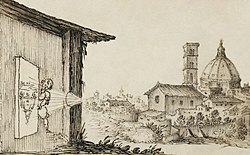The camera obscura (Latin; "camera" is a "vaulted chamber/room" + "obscura" means "dark"= "darkened chamber/room") is an optical device that projects an image of its surroundings on a screen. It is used in drawing and for entertainment, and was one of the
History
The pinhole camera and camera obscura are sometimes credited to Ibn al-Haytham (Alhazen, 965–1039 AD) [4][verification needed] for the first clear description[5] and correct analysis[6] of the device and for first describing how an image is formed in the eye using the camera obscura as an analogy.[7][verification needed]However, camera obscura was known to earlier scholars since the time of Mozi and Aristotle.[8] Euclid's Optics (ca 300 BC), presupposed the camera obscura as a demonstration that light travels in straight lines.[9] When Ibn al-Haytham began experimenting with the camera obscura phenomenon, he stated (in Latin translation), Et nos non inventimus ita, "we did not invent this".[10]
In the 4th century BC, Aristotle noted that "sunlight travelling through small openings between the leaves of a tree, the holes of a sieve, the openings wickerwork, and even interlaced fingers will create circular patches of light on the ground." In the 4th century AD, Theon of Alexandria observed how "candlelight passing through a pinhole will create an illuminated spot on a screen that is directly in line with the aperture and the center of the candle." In the 9th century, Al-Kindi (Alkindus) demonstrated that "light from the right side of the flame will pass through the aperture and end up on the left side of the screen, while light from the left side of the flame will pass through the aperture and end up on the right side of the screen." While these earlier scholars described the effects of a single light passing through a pinhole, none of them suggested that what is being projected onto the screen is an image of everything on the other side of the aperture. Ibn al-Haytham's Book of Optics (1021) was the first to demonstrate this with his lamp experiment where several different light sources are arranged across a large area, and he was thus the first scientist to successfully project an entire image from outdoors onto a screen indoors with the camera obscura.[11][unreliable source?]
Several decades after Ibn al-Haytham's death, the Song Dynasty Chinese scientist Shen Kuo (1031–1095) experimented with camera obscura, and was the first to apply geometrical and quantitative attributes to it in his book of 1088 AD, the Dream Pool Essays.[12][verification needed] However, Shen Kuo alluded to the fact that the Miscellaneous Morsels from Youyang written in about 840 AD by Duan Chengshi (d. 863) during the Tang Dynasty (618–907) mentioned inverting the image of a Chinese pagoda tower beside a seashore.[12] In fact, Shen makes no assertion that he was the first to experiment with such a device.[12] Shen wrote of Cheng's book: "[Miscellaneous Morsels from Youyang] said that the image of the pagoda is inverted because it is beside the sea, and that the sea has that effect. This is nonsense. It is a normal principle that the image is inverted after passing through the small hole."[12]
In 13th-century England Roger Bacon described the use of a camera obscura for the safe observation of solar eclipses.[13] Its potential as a drawing aid may have been familiar to artists by as early as the 15th century; Leonardo da Vinci (1452–1519 AD) described camera obscura in Codex Atlanticus. Johann Zahn's Oculus Artificialis Teledioptricus Sive Telescopium was published in 1685. This work contains many descriptions and diagrams, illustrations and sketches of both the camera obscura and of the magic lantern.
The Dutch Masters, such as Johannes Vermeer, who were hired as painters in the 17th century, were known for their magnificent attention to detail. It has been widely speculated that they made use of such a camera, but the extent of their use by artists at this period remains a matter of considerable controversy, recently revived by the Hockney-Falco thesis. The term "camera obscura" was first used by the German astronomer Johannes Kepler in 1604.[14] The English physician and author Sir Thomas Browne speculated upon the inter-related workings of optics and the camera obscura in his 1658 Discourse The Garden of Cyrus thus-
For at the eye the Pyramidal rayes from the object, receive a decussation, and so strike a second base upon the Retina or hinder coat, the proper organ of Vision; wherein the pictures from objects are represented, answerable to the paper, or wall in the dark chamber; after the decussation of the rayes at the hole of the hornycoat, and their refraction upon the Christalline humour, answering the foramen of the window, and the convex or burning-glasses, which refract the rayes that enter it.


Thanks for these Mizan! But what happened to you in class?! You have now missed or been late a significant amount of time. Try to come see me ASAP!
ReplyDeleteProfessor Jerskey